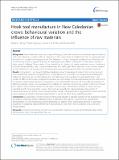Hook tool manufacture in New Caledonian crows : behavioural variation and the influence of raw materials
Abstract
Background: New Caledonian crows use a range of foraging tools, and are the only non-human species known to craft hooks. Based on a small number of observations, their manufacture of hooked stick tools has previously been described as a complex, multi-stage process. Tool behaviour is shaped by genetic predispositions, individual and social learning, and/or ecological influences, but disentangling the relative contributions of these factors remains a major research challenge. The properties of raw materials are an obvious, but largely overlooked, source of variation in tool-manufacture behaviour. We conducted experiments with wild-caught New Caledonian crows, to assess variation in their hooked stick tool making, and to investigate how raw-material properties affect the manufacture process. Results: In Experiment 1, we showed that New Caledonian crows’ manufacture of hooked stick tools can be much more variable than previously thought (85 tools by 18 subjects), and can involve two newly-discovered behaviours: ‘pulling’ for detaching stems and bending of the tool shaft. Crows’ tool manufactures varied significantly: in the number of different action types employed; in the time spent processing the hook and bending the tool shaft; and in the structure of processing sequences. In Experiment 2, we examined the interaction of crows with raw materials of different properties, using a novel paradigm that enabled us to determine subjects’ rank-ordered preferences (42 tools by 7 subjects). Plant properties influenced: the order in which crows selected stems; whether a hooked tool was manufactured; the time required to release a basic tool; and, possibly, the release technique, the number of behavioural actions, and aspects of processing behaviour. Results from Experiment 2 suggested that at least part of the natural behavioural variation observed in Experiment 1 is due to the effect of raw-material properties. Conclusions: Our discovery of novel manufacture behaviours indicates a plausible scenario for the evolutionary origins, and gradual refinement, of New Caledonian crows’ hooked stick tool making. Furthermore, our experimental demonstration of a link between raw-material properties and aspects of tool manufacture provides an alternative hypothesis for explaining regional differences in tool behaviours observed in New Caledonian crows, and some primate species.
Citation
Klump , B C , Sugasawa , S , St Clair , J & Rutz , C 2015 , ' Hook tool manufacture in New Caledonian crows : behavioural variation and the influence of raw materials ' , BMC Biology , vol. 13 , 97 . https://doi.org/10.1186/s12915-015-0204-7
Publication
BMC Biology
Status
Peer reviewed
ISSN
1741-7007Type
Journal article
Description
Funding: BBSRC grants BB/G023913/1 and BB/G023913/2Collections
Items in the St Andrews Research Repository are protected by copyright, with all rights reserved, unless otherwise indicated.

